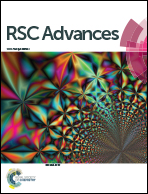Fe-MOFs prepared with the DBD plasma method for efficient Fenton catalysis
Abstract
Fe-MOFs were successfully synthesized with the dielectric barrier discharge (DBD) plasma method, and applied for degradation of methyl orange by the Fenton process. Fe-MOFs were characterized by XRD, SEM, EDS, BET and FT-IR. A systematic study was carried out to optimize the synthesis conditions, taking into account the Fenton capacity performance for degradation of methyl orange. The optimal synthesis conditions were a discharge time of 100 min, discharge voltage of 18 kV, reactant concentration of 14 g L−1 and reactant mass ratio (TA : FeCl3·6H2O) of 1 : 5, with influence on the crystallization, morphologies and particle size. The degradation rate of methyl orange could reach 85% within 40 min with the MO concentration of 50 mg L−1, Fe-MOF dosage of 0.12 g L−1, pH of 5 and H2O2 at 1 mL L−1. Meanwhile, the Fenton catalytic process was conducted covering a range of catalyst concentrations, initial MO concentrations, pH and H2O2 amounts. Higher catalyst concentration, lower MO initial concentration, pH of 3 and H2O2 amount of 1 mL L−1 were conducive to the degradation efficiency.



 Please wait while we load your content...
Please wait while we load your content...